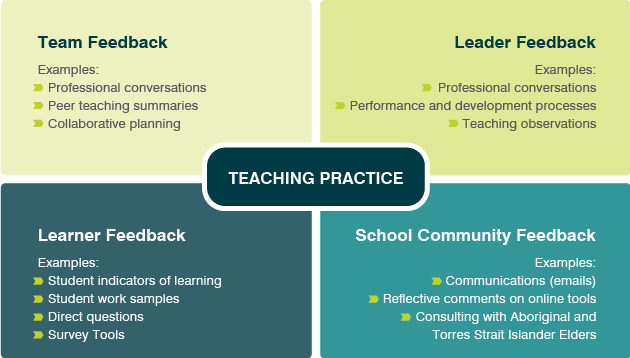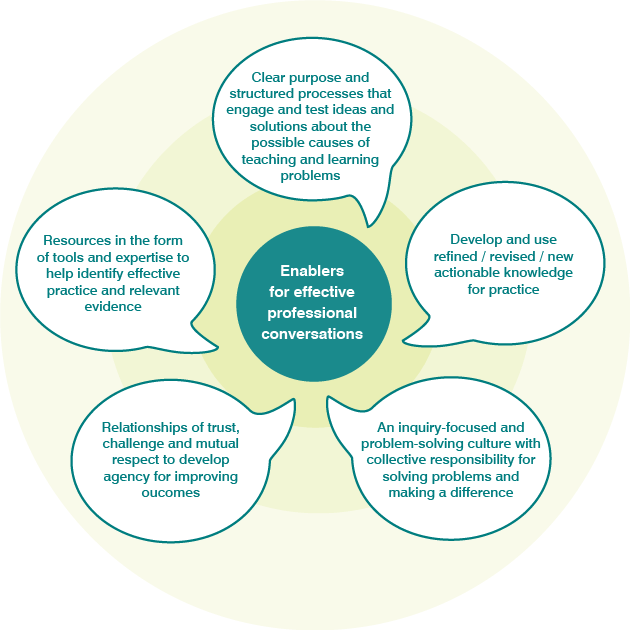Feedback is information that is exchanged between a teacher and another person to help inform teaching and learning performance. Feedback is most useful when it is based on evidence and is relative to the learning goals of teachers and learners.
Feedback can be both informal and formal and can look different according to the teaching level, location and culture of the education setting.

An accurate self-image is a good predictor of success at work. It increases your ability to assess the risks and challenges when taking on tasks and it means you are more likely to ask for help if you need it.
One of the most effective ways to learn about yourself and create an accurate self-image is to seek feedback. Feedback helps you to understand your teaching practice from the perspective of the people that are most affected by it.
Feedback is the basis for deep insights and reflections. These insights and reflections pave the way for changes in your teaching practice that have impact and are sustained.
If you want more insight into your effectiveness as a teacher, you can seek feedback from anyone who is impacted by your teaching practice.
Team feedback | Your colleagues can provide feedback on specific aspects of your teaching practice, including student engagement, classroom management, learning tasks and activities and lesson plans. You can also get feedback on how you communicate
and collaborate with colleagues. Examples: - Classroom observation, peer-feedback groups, learning and teaching teams, one-on-one catch-up feedback, informal in-the-moment feedback, professional learning teams
|
Leader feedback | Your school leader can comment on your goal achievement and development more broadly, how you are contributing to the vision for the school, your behaviours and your teaching practice. Examples: - Regular catch-ups, formal meetings to discuss, performance and development plan progress, informal in-the-moment feedback
|
Learner feedback | Learners are the people most directly affected by your teaching practice. They can provide information on your effectiveness in the classroom by reporting how engaged they are, how appropriate the learning resources are, if you are
meeting their learning needs, and if you are providing a culturally safe learning environment. Examples: - Student feedback surveys, student focus groups, targeted interviews, informal in-the-moment feedback.
|
School community feedback | Feedback from parents and community members will most likely focus on the observed impact of your teaching on learners – through student motivation, application of new learning outside the school, and how you engage them in the
learning process. Feedback from diverse members of the community will provide perspective on your culturally responsive practices and the cultural safety of the learning environment. Examples: - Parent feedback surveys, parent focus groups, parent-teacher interviews, community events, informal in-the-moment feedback, school blogs.
|
Activity
Highlight or record examples of feedback gathered in your practice and education setting.
How effective is your use of feedback to improve teaching practice? Has feedback lead to changes in practice?
AITSL commissioned Professor Helen Timperley to undertake the Professional Conversations and Improvement-Focused Feedback literature review to draw together national and international research in relation to conversations that support professional growth. This review found five enablers for effective professional conversations, outlined below.

Resources
Resources in the form of tools and expertise are essential in shaping the quality and direction of conversations.
Tools and expertise should bring high quality information to conversations, supporting participants to challenge each other to improve practice, solve problems and promote better outcomes for students.
Expertise in conversational processes is essential for productive conversations.
Relationships
Relationships are developed through conversations and do not necessarily exist prior to them.
Relationships of trust and mutual respect need to be accompanied by challenge and high expectations for the conversations to be effective.
Relationships build agency so that each person is committed and believes that it is within an individual or group’s capacity to make a difference.
Processes
Clarity is enhanced when the participants in a conversation have a shared understanding of its purpose and there are processes in place to achieve that purpose.
Processes should be sufficiently flexible to allow all participants to express, engage and test different ideas.
Effective processes should resolve the dichotomy of ‘asking questions’ versus ‘telling’ by treating all views as hypotheses, testing their validity through deep inquiry and developing integrative solutions.
Knowledge
Knowledge is both an outcome of the conversation and a resource brought to it as participants come to see things in a different way.
New knowledge arises from a mix of context-specific individual theories of practice, leaders’, colleagues’ and expert theories of practice, or research-based theories.
Knowledge must be directly applicable to the participants’ contexts and actionable in that context if it is to be used.
Culture
A culture focused on improving outcomes provides purpose and is both an enabler and an outcome of conversations as they develop over time.
The culture can facilitate a shift from participants attributing particular problems to outside influences to participants focusing on their own interactions with others and what can be changed.
Through this improvement-focused culture and the shifting of attributions, conversations create the professional agency needed to make progress towards achieving particular outcomes.
Professional conversations are a vehicle for improvement-focused feedback among teachers for developing leadership, teaching and student learning. Professional knowledge is constructed through social interaction in social communities of practice with
a range of stakeholder individuals and groups . If used well, productive dialogue between colleagues may increase the value of the feedback process and lead to a greater impact on student outcomes.
Reflection
Consider the following questions about the five enablers.
Teacher perspective | Leader perspective |
|---|
Which of the enablers are evident in your practice and in which ways? | Which of the enablers are evident in your leadership and in which ways? |
Which of the enablers could be developed more within your practice and how could you prioritise this? | Which of the enablers could be developed more within your education setting and how could you prioritise this? |
Activity
As an individual or team, choose one or more practices to test in your education setting. In the following section you will refer back to this choice and consider how to evaluate your progress.
Team feedback
Leader feedback
Learner feedback
School community feedback
Which practice/s will you test?
Evaluating new feedback practices is essential and should be considered from the outset. Evaluation reveals barriers and enablers, the level of impact on student learning and outcomes, and is the basis for a decision on if you should continue with the
introduced approach.
Evaluating the impact ensures that your education setting is using its resources well to improve student learning. The evaluation needs to focus on two parts:
- Measuring the impact by answering the question, “Has there been an improvement in students’ learning?” (Hattie, 2015)
- Identifying the active ingredients involved in the implementation of the approach that worked in your setting and how they worked (Sharples, 2013).
When responding to the second part, consider the support system for implementing feedback as well as the actual feedback practices introduced (Domitrovich, et al, 2008). The support system refers to how the education setting supports teachers to implement
effective feedback practices through resources, coordination, alignment with wider priorities and processes, monitoring of activities and professional learning opportunities. The support system aims to ensure consistency in the quality of a new approach.
Activity
Record reflections about the new feedback practice/s you have tried.
What worked well and what evidence did you consider? Where is the connection to improved learner outcomes?
What obstacles did you encounter and what evidence helped you understand improvements that might be needed?
Continue your learning by moving on to
Alternatively, return to the